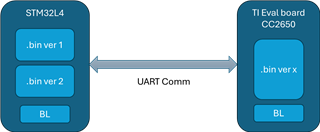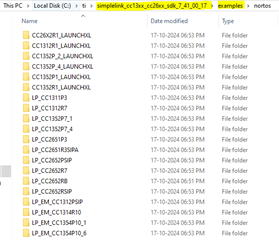Other Parts Discussed in Thread: CC2650, CC2340R5
Tool/software:
hi team
1. Any examples for serial boot via UART
Aim is to update the TI firmware via serila boot (UART Communiaction ) By using STM32 (This has the latest version of the bin file that needs to be flashed in TI)

Note TI Eval kit : TEXAS INSTRUMENT LAUNCHXL-CC2650 Development Boards & Kits
2. could please provide us the suitable SDK examples got an SDK But it doesnt supports our Eval kit CC2650.
In the file "simplelink_cc13xx_cc26xx_sdk_7_41_00_17", we are unable to find our board series example, which specifically addresses the evaluation kit.

I am eagerly awaiting your reply.
Regards
George


